What Every Professional Photographer Ought To Learn About Lights
What Every Professional Photographer Ought To Learn About Lights
Blog Article
Content By-Rogers Riddle
As a professional photographer, you understand that illumination can make or damage your photos. Understanding the nuances of both all-natural and man-made light is important for capturing the state of mind and quality you go for in your job. Whether you're chasing after the excellent golden hour radiance or fine-tuning your artificial configurations, mastering these aspects can elevate your digital photography considerably. But there are common challenges that lots of ignore, and recognizing them can transform your technique to every shoot. Let's discover what you might be missing and just how it can affect your outcomes.
Understanding Natural Light
Understanding natural light is essential for any kind of digital photographer wanting to enhance their work. It's the structure of terrific digital photography, affecting mood, tone, and quality. When you fire outdoors, focus on the moment of day. The gold hour-- shortly after sunup and prior to sundown-- supplies soft, cozy light that can change regular scenes into spectacular pictures.
Don't underestimate the power of cloudy days. Cloud cover diffuses sunlight, developing a soft, even light that's ideal for portraits and macro photography. You'll find colors appear this sort of lighting without severe darkness.
Positioning matters, too. Always consider your subject's orientation to the source of light. If the sun's behind your topic, you may end up with a shape, which can be significant yet mightn't be what you want. Conversely, straight sunlight can create uncomplimentary shadows.
Try out angles; often, transforming your viewpoint can yield remarkable outcomes. Usage all-natural reflectors, like water or sand, to jump light onto your topic, including measurement.
Learning Artificial Light
Mastering synthetic light is essential for professional photographers that intend to take their abilities to the next degree. Whether you're making use of speedlights, workshop strobes, or constant lights, understanding exactly how to control these resources can significantly improve your photos.
Start by familiarizing on your own with the essentials of light quality, instructions, and color temperature level. Trying out different modifiers like softboxes, umbrellas, or grids to control the soft qualities or cruelty of the light.
You'll discover that soft light commonly creates flattering results, while harsher light can include drama and deepness. Don't avoid darkness; they can improve the three-dimensionality of your topics.
Pay attention to the placement of your lights. A light located too close to your topic can develop uncomplimentary outcomes, while too far can result in an absence of information. Use a light meter or your camera's pie chart to ensure you're exposing appropriately.
Last but not least, keep in mind that synthetic light can be blended with ambient light for creative impacts. Stabilizing these sources might take technique, once you understand it, your digital photography will genuinely radiate.
Strategies for Various Circumstances
When you enter various shooting scenarios, adapting your lighting strategies is critical for catching the very best pictures. For exterior portraits, use the gold hour-- morning or late afternoon light-- to soften darkness and improve skin tones.
If it's a harsh midday sun, take into consideration using a reflector to bounce light back onto your topic or seek shaded areas for an extra also direct exposure.
In low-light scenarios, like indoor events, boost your ISO and use a large aperture to allow in more light. A tripod can assist get rid of cam shake, enabling longer exposures without obscuring.
If you're contending night, experiment with off-camera flash to develop dynamic lights and depth in your pictures.
For item digital photography, use diffused illumination to avoid rough reflections. Softboxes or light camping tents can help achieve this effect.
When photographing https://telegra.ph/Learn-To-Uncover-Your-Distinct-Photographic-Design-By-Discovering-Impacts-And-Strategies-However-What-Unexpected-Discoveries-Awa-01-08 , take into consideration the instructions of light and time of day, as it can considerably transform the mood of your shot.
Always prepare to adjust your setups and placing based on the scenario, as adaptability is crucial to mastering lighting in photography.
Final thought
In conclusion, mastering lights is crucial to boosting your digital photography skills. Accept natural light's elegance throughout golden hour, and don't shy away from trying out man-made light techniques. By adapting your method to various situations, you'll record stunning pictures that resonate with feeling and clearness. Remember, the appropriate lights can transform an average shot into something remarkable, so keep exercising and fine-tuning your understanding of both natural and fabricated light. https://www.11alive.com/article/entertainment/television/programs/the-a-scene/the-photograph-lands/85-d02438a1-1432-46c4-b550-0026a02d90b6 !
